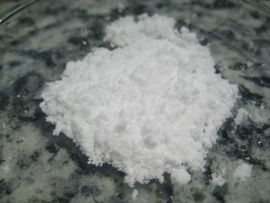Potassium perchlorate
 Potassium perchlorate is a white solid
| |
| Names | |
|---|---|
| IUPAC name
Potassium perchlorate
| |
| Other names
Potassium chlorate(VII)
| |
| Properties | |
| KClO4 | |
| Molar mass | 138.55 g/mol |
| Appearance | White crystalline solid |
| Odor | Odorless |
| Density | 2.5239 g/cm3 |
| Melting point | 610 °C (1,130 °F; 883 K) |
| Boiling point | Decomp. starts at 400 °C |
| 0.76 g/100 ml (0 °C) 1.5 g/100 ml (25 °C) 4.76 g/100 ml (40 °C) 21.08 g/100 ml (100 °C) | |
| Solubility | Reacts with sulfuric acid Insoluble in alcohols, diethyl ether, toluene, xylene |
| Vapor pressure | ~0 mmHg |
| Hazards | |
| Safety data sheet | Sigma-Aldrich |
| Flash point | Non-flammable |
| Related compounds | |
| Related compounds
|
Potassium hypochlorite Potassium chlorite Potassium chlorate |
| Except where otherwise noted, data are given for materials in their standard state (at 25 °C [77 °F], 100 kPa). | |
| Infobox references | |
Potassium perchlorate is the inorganic salt with the chemical formula KClO4.
Contents
Properties
Chemical
Just like any perchlorate, this salt is a strong oxidizer and reacts violently with many organic substances at elevated temperatures.
It reacts with a strong acid, such as sulfuric acid, to release perchloric acid.
- KClO4 + H2SO4 → KHSO4 + HClO4
Physical
Potassium perchlorate is a colorless, crystalline solid salt. It has the lowest solubility in water of any alkali perchlorate, 1.5 g / 100 ml water at 25 °C. It is not hygroscopic and does not form hydrates.
Availability
Potassium perchlorate can be found in certain antithyroid medications, albeit the quantity is small. The sale of potassium perchlorate is regulated in most countries due to its powerful oxidizing properties.
Preparation
Potassium perchlorate can be prepared by reacting a potassium salt, usually potassium chloride with sodium perchlorate. Potassium perchlorate will precipitate due to its low solubility. Filter and dry the perchlorate precipitate. It may be beneficial to heat the solution after mixing the potassium salt with the perchlorate. After cooling the potassium perchlorate forms somewhat bigger crystals that are easier to deal with than a fine powder.
While KClO4 can also be prepared by electrolysis of potassium chloride in water, the yield is very poor, due to its low solubility, as well as the low solubility of its precursor, potassium chlorate.
Projects
- Flash powder
- Colored star compositions
- Oxygen source
Handling
Safety
Potassium perchlorate is a powerful oxidizer. When handling it, it should be kept away from any open flame as well as organic substances. Unlike the chlorate salt, perchlorate mixtures with sulfur are stable.
It is moderately toxic, in large amounts it interferes with iodine uptake into the thyroid gland.
Storage
Potassium perchlorate must be stored away from any strong mineral acid as well as any reducing agent, in sealed bottles. As it is not hygroscopic, it does not require dry environment. Any clean plastic bottle can be used as storage container.
Disposal
Potassium perchlorate can be neutralized by reacting it with a reducing agent. This, however, only can be done at elevated temperatures.
Perchlorates can be destroyed with metallic iron under UV light, in the absence of air.[1]